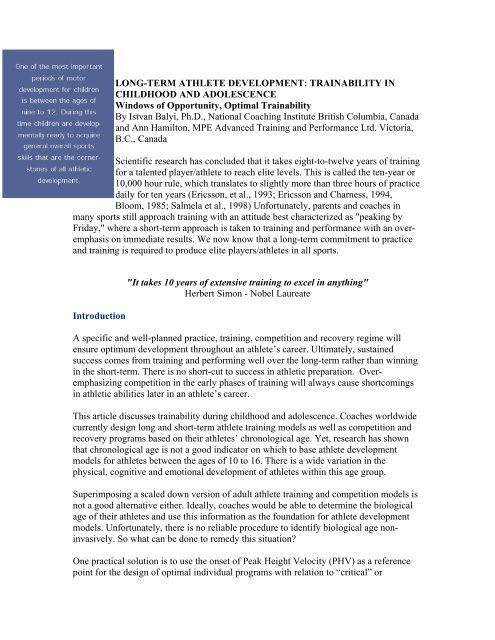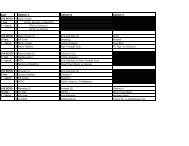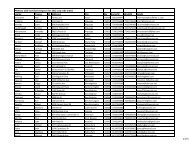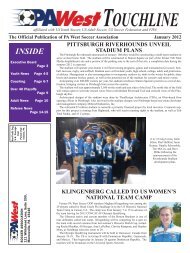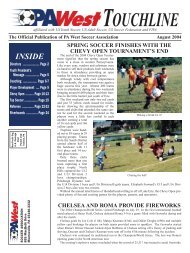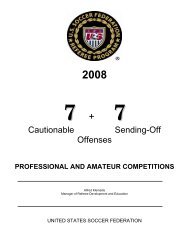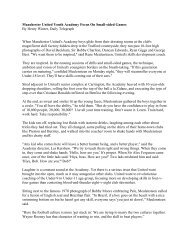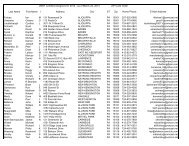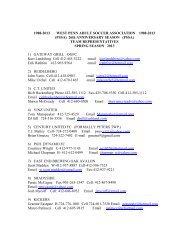LONG-TERM ATHLETE DEVELOPMENT: TRAINABILITY IN ...
LONG-TERM ATHLETE DEVELOPMENT: TRAINABILITY IN ...
LONG-TERM ATHLETE DEVELOPMENT: TRAINABILITY IN ...
You also want an ePaper? Increase the reach of your titles
YUMPU automatically turns print PDFs into web optimized ePapers that Google loves.
<strong>LONG</strong>-<strong>TERM</strong> <strong>ATHLETE</strong> <strong>DEVELOPMENT</strong>: <strong>TRA<strong>IN</strong>ABILITY</strong> <strong>IN</strong><br />
CHILDHOOD AND ADOLESCENCE<br />
Windows of Opportunity, Optimal Trainability<br />
By Istvan Balyi, Ph.D., National Coaching Institute British Columbia, Canada<br />
and Ann Hamilton, MPE Advanced Training and Performance Ltd. Victoria,<br />
B.C., Canada<br />
Scientific research has concluded that it takes eight-to-twelve years of training<br />
for a talented player/athlete to reach elite levels. This is called the ten-year or<br />
10,000 hour rule, which translates to slightly more than three hours of practice<br />
daily for ten years (Ericsson, et al., 1993; Ericsson and Charness, 1994,<br />
Bloom, 1985; Salmela et al., 1998) Unfortunately, parents and coaches in<br />
many sports still approach training with an attitude best characterized as "peaking by<br />
Friday," where a short-term approach is taken to training and performance with an overemphasis<br />
on immediate results. We now know that a long-term commitment to practice<br />
and training is required to produce elite players/athletes in all sports.<br />
Introduction<br />
"It takes 10 years of extensive training to excel in anything"<br />
Herbert Simon - Nobel Laureate<br />
A specific and well-planned practice, training, competition and recovery regime will<br />
ensure optimum development throughout an athlete’s career. Ultimately, sustained<br />
success comes from training and performing well over the long-term rather than winning<br />
in the short-term. There is no short-cut to success in athletic preparation. Overemphasizing<br />
competition in the early phases of training will always cause shortcomings<br />
in athletic abilities later in an athlete’s career.<br />
This article discusses trainability during childhood and adolescence. Coaches worldwide<br />
currently design long and short-term athlete training models as well as competition and<br />
recovery programs based on their athletes’ chronological age. Yet, research has shown<br />
that chronological age is not a good indicator on which to base athlete development<br />
models for athletes between the ages of 10 to 16. There is a wide variation in the<br />
physical, cognitive and emotional development of athletes within this age group.<br />
Superimposing a scaled down version of adult athlete training and competition models is<br />
not a good alternative either. Ideally, coaches would be able to determine the biological<br />
age of their athletes and use this information as the foundation for athlete development<br />
models. Unfortunately, there is no reliable procedure to identify biological age noninvasively.<br />
So what can be done to remedy this situation?<br />
One practical solution is to use the onset of Peak Height Velocity (PHV) as a reference<br />
point for the design of optimal individual programs with relation to “critical” or
“sensitive” periods of trainability during the maturation process.<br />
Prior to the onset of PHV, boys and girls can train together and chronological age can be<br />
used to determine training, competition and recovery programs. The average age for the<br />
onset of PHV is 12 and 14 years for females and males respectively. The onset of PHV is<br />
influenced by both genetic and environmental factors, including climate, cultural<br />
influences, and social environment.<br />
The onset of PHV is a reference point that provides valuable information for training the<br />
athletes’ energy systems and Central Nervous System (CNS), regardless of chronological<br />
age. Using simple measurements, PHV can be monitored and training can be related and<br />
optimised to exploit the critical periods of trainability. This approach can enhance the<br />
development of short and long-term individually optimized training, competition and<br />
recovery programs such the optimal window of accelerated adaptation to stamina<br />
(endurance), strength, speed, skill and suppleness training – or the Five S’s of training<br />
and performance.<br />
It should be pointed out that all energy systems are always trainable, but during the socalled<br />
“critical” periods accelerated adaptation will take place if the proper volume,<br />
intensity and frequency of exercise are implemented.<br />
The Model of Long-Term Athlete Development<br />
Sports can generally be classified as early specialization or late specialization sports.<br />
Early specialization refers to the fact that some sports, such as diving, figure skating,<br />
gymnastics, rhythmic gymnastics, and table tennis require early sport-specific<br />
specialization in training.<br />
Late specialization sports, including track and field, combative sports, cycling, racquet<br />
sports, rowing and all team sports require a generalised approach to early training. For<br />
these sports, the emphasis during the first two phases of training should be on the<br />
development of general motor and technical-tactical skills. Early specialization sports<br />
require a four-phase model, while late specialization sports require a six-stage model:<br />
Early Specialization Model<br />
Late Specialization Model<br />
1. Training to Train stage 1. FUNdamental stage<br />
2. Training to Compete 2. Learning to Train<br />
3. Training to Win 3. Training to Train<br />
4. Retirement / retainment 4. Training to Compete<br />
5. Training to Win<br />
6. Retirement / retainment<br />
These models are generic in nature and will require adjustment on a sport specific basis.<br />
Since there are only a few sports that can be categorized as early specialization sports,
this article focuses on late specialization sports. Each early specialization sport should<br />
develop a sport-specific model of its own. A generic model would<br />
lead to serious oversimplifications. The challenge for early<br />
specialization sports is to find a way to either combine the<br />
“FUNdamental” and “Learning to Train” stages or to amalgamate<br />
them into a single stage. For late specialization sports, specialization<br />
prior to age ten is not recommended since this contributes to early<br />
athlete burn-out, drop-out and retirement from training and<br />
competition.<br />
THE SIX-STAGE MODEL OF LATE SPECIALIZATION<br />
SPORTS<br />
Stage 1 – The FUNdamental Stage TM<br />
AGE: Males 6 - 9 / Females 6 - 8 years<br />
Objective: Learn all fundamental movement skills (build overall motor skills)<br />
Fundamental movement skills should be practiced and mastered before sport-specific<br />
skills are introduced. The development of these skills, using a positive and fun approach,<br />
will contribute significantly to future athletic achievements. Participation in a wide range<br />
of sports is also encouraged. This emphasis on motor development will produce<br />
players/athletes who have a better trainability for long-term, sport-specific development.<br />
Fundamental movement skills are observable as locomotor, manipulative and stability<br />
skills. There are three stages of fundamental movement skill development: initial (2-3<br />
years), elementary (4–5 years) and mature (6–7 years).<br />
The “FUNdamental” phase should be well structured and fun! The emphasis is on the<br />
overall development of the player/athlete’s physical capacities and fundamental<br />
movement skills, and the ABC's of athleticism - Agility, Balance, Coordination and<br />
Speed. Participation in as many sports as possible is encouraged. Speed, power and<br />
endurance are developed using FUN games. Appropriate and correct running, jumping<br />
and throwing techniques are taught using the ABC's of athletics.<br />
The first ‘window of accelerated adaptation to speed’ or ‘critical period of speed<br />
development’ will occur during this phase, age 6-8 for girls and 7-9 for boys respectively.<br />
Linear, lateral and multi-directional speed should be developed and the duration of the<br />
repetitions should be less than 5 seconds. This is often called the ‘agility, quickness,<br />
change of direction’ window. Again, fun and games should be used for speed training and<br />
the volume of training should be lower.<br />
Strength training during this phase should include exercises using the child’s own body
weight; medicine ball and Swiss ball exercises. Children should be introduced to<br />
the simple rules and ethics of sports. No periodization takes place, but all<br />
programs are structured and monitored. Activities revolve around the school year<br />
and during summer and winter holidays, multi-sport camps are recommended. If<br />
children and parents have a preferred sport, participation once or twice per week is<br />
recommended, but participation in other sports three or four times per week is essential<br />
for future excellence. If the children later decide to leave the competitive stream, the<br />
skills they have acquired during the Fundamental phase will still benefit them when they<br />
engage in recreational activities, which will enhance their quality of life and health.<br />
Stage 2 – The learning to train stage<br />
AGE: Males 9 – 12 / Females 8 – 11 years<br />
Objective: Learn all fundamental sports skills (build overall sports skills)<br />
Specialized movement skills are developed from age seven to age eleven, and are<br />
specialized sports skills. By passing the fundamental and specialized skill development<br />
phase is likely to be detrimental to the child’s future engagement in physical activity and<br />
sport. Early specialization in late specialization sports can also be detrimental to the<br />
proceeding stages of skill development.<br />
One of the most important periods of motor development for children is between the ages<br />
of nine to 12. During this time children are developmentally ready to acquire general<br />
overall sports skills that are the cornerstones of all athletic development.<br />
This is the ‘window of accelerated adaptation to motor coordination’. All fundamental<br />
movement skills should be further developed and general overall sports skills should be<br />
learned during this phase.<br />
If fundamental motor skill training is not developed between the ages of eight to 11 and<br />
nine to 12 respectively for females and males, a significant window of opportunity has<br />
been lost, compromising the ability of the young player/athlete to reach his/her full<br />
potential.<br />
Strength should be developed by medicine ball, Swiss ball and own body-weight<br />
exercises as well as hopping-bounding exercises (or routines). Endurance should be<br />
developed further by games and relays. Basic flexibility exercises should be introduced<br />
during this phase, while speed can be developed further with specific activities during the<br />
warm-up, such as agility, quickness and change of direction. Competition should be well<br />
structured. The most suitable framework is single periodization for this phase, however<br />
for a few sports, sport-specific needs will warrant double periodization (e.g. swimming,<br />
tennis). A 70:30 training/practice to competition-ratio is recommended.
Stage 3 – The Training to Train Stage TM<br />
AGE: Males 12 - 16 / Females 11 - 15 years<br />
Objectives: Build the aerobic base, build strength towards the end of the phase and<br />
further develop sport-specific skills (build the “engine” and consolidate sport specific<br />
skills).<br />
During the “Training to Train” stage young athletes consolidate basic sport-specific skills<br />
and tactics. This phase is a ‘window of accelerated adaptation to aerobic and strength<br />
training.’ Optimal aerobic trainability begins with the onset of Peak Height Velocity<br />
(PHV) or the major growth spurt during maturation. Aerobic training should be<br />
prioritized after the onset of PHV, while skill, speed and strength should be maintained or<br />
developed further. Special emphasis is also required for flexibility training due to the<br />
sudden growth of bones, tendons, ligaments and muscles.<br />
There are two windows of accelerated adaptation to strength training for females.<br />
Window one is immediately after PHV and window two begins with the onset of<br />
menarche (the first menstrual period). This window for males begins 12 - 18 months after<br />
PHV.<br />
It should be noted that both aerobic and strength trainability is dependent on maturation<br />
levels, thus early, average or late maturers need different timing of the training emphasis.<br />
At present most of these decisions are made on chronological age (age groups) and not on<br />
individual, maturation level needs.<br />
Single, double and occasionally (depending on sport-specific demands) triple<br />
periodization is the optimal framework of preparation during this phase. During<br />
competitions athletes play to win and to do their best, but the major focus of training is on<br />
learning the basics as opposed to competing. Training and competition ratios are<br />
optimized because too many competitions waste valuable training time and conversely,<br />
not enough competition inhibits the practice of technical/tactical skills and learning how<br />
to cope with the physical and mental challenges presented during competition.<br />
A 60 percent training to 40 percent competition ratio is recommended by experts during<br />
the “Training to Train” phase and the 40 percent competition ratio includes competition<br />
and competition-specific training. However, these percentages vary according to sport<br />
and individual specific needs. Athletes undertaking this type of preparation will be better<br />
prepared for competition in both the short and long-term, than those who focus solely on<br />
winning. During this phase, athletes train in competitive situations daily, in the form of<br />
practice matches or competitive games and drills.<br />
The “Training to Train” phase addresses two of the critical or sensitive periods of<br />
physical development. Athletes who miss this phase of training will not reach their full<br />
potential, as these critical periods have been missed. The reason why so many athletes<br />
plateau during the later stage of their careers is primarily because of an over emphasis on
competition instead of on training during this important period in their athletic<br />
development.<br />
The “Learn to Train” and “Training to Train” stages are the most important phases of<br />
athletic preparation. During these stages ‘we make or break an athlete!’<br />
Stage 4 – The Training to Compete Stage TM<br />
AGE: Males 16 - 18 / Females 15 - 17 years<br />
Objectives: Optimize fitness preparation and sport, individual and position- specific skills<br />
as well as performance (optimize “engine”, skills and performance).<br />
This phase of development is introduced after the goals and objectives of the<br />
“Training to Train” stage have been achieved. The training to competition and<br />
competition-specific training ratio now changes to 50:50. Fifty percent of available<br />
time is devoted to the development of technical and tactical skills and fitness<br />
improvements, and fifty percent is devoted to competition and competition-specific<br />
training.<br />
During the “Training to Compete” phase, high intensity individual event and<br />
position-specific training is provided to athletes year-round. Athletes, who are now<br />
proficient at performing both basic and sport specific skills, learn to perform these<br />
skills under a variety of competitive conditions during training. Special emphasis is<br />
placed on optimum preparation by modelling training and competition. Fitness<br />
programs, recovery programs, psychological preparation and technical development<br />
are now individually tailored to a greater degree. This emphasis on individual preparation<br />
addresses each athlete’s individual strengths and weaknesses. Double and multiple<br />
periodization is the optimal framework of preparation.<br />
Stage 5 – The Training to Win Stage TM<br />
AGE: Males 18 years and older / Females 17 years and older<br />
Objectives: Maximize fitness preparation and sport, individual and position specific skills<br />
as well as performance (maximize “engine”, skills and performance)<br />
This is the final phase of athletic preparation. All of the athlete’s physical, technical,<br />
tactical, mental, personal and lifestyle capacities are now fully established and the focus<br />
of training has shifted to the maximization of performance. Athletes are trained to peak<br />
for major competitions. Training is characterized by high intensity and relatively high<br />
volume. Frequent “prophylactic” (preventative) breaks help to prevent physical and<br />
mental burnouts. Training to competition ratio in this phase is 25:75, with the<br />
competition percentage including competition-specific training activities.
Stage 6 – The Retirement / Retention stage<br />
Objectives: Retain athletes for coaching, administration, officials, etc.<br />
This phase refers to the activities performed after an athlete has retired from competition<br />
permanently. During this final phase, some ex-athletes move into sport-related careers<br />
that may include coaching, officiating, sport administration, small business enterprises,<br />
master’s competition, media, etc.<br />
Table One, (Appendix One) provides a generic outline of trainability. It identifies the<br />
various windows of trainability, showing chronological age, general and specific training<br />
age, the five stages of long-term athlete development, trainability windows and the<br />
moving scales of aerobic and strength trainability during the maturation period.<br />
In this table, no arrow indicates chronological age, while arrows indicate moving scales,<br />
depending on the onset of PHV. Before the onset of PHV, and after maturation (post<br />
puberty) simple testing can determine training priorities, taking into consideration the<br />
windows of accelerated adaptation to training. This generic table can easily be adjusted to<br />
sport-specific norms and demands.


